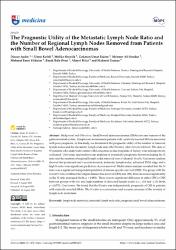| dc.contributor.author | Aydın, Dinçer | |
| dc.contributor.author | Kefeli, Umut | |
| dc.contributor.author | Özçelik, Melike | |
| dc.contributor.author | Erdem, Gökmen Umut | |
| dc.contributor.author | Şendur, Mehmet Ali | |
| dc.contributor.author | Yıldırım, Mahmut Emre | |
| dc.contributor.author | Öven, Bala Başak | |
| dc.contributor.author | Bilici, Ahmet | |
| dc.contributor.author | Gümüş, Mahmut | |
| dc.date.accessioned | 2023-09-12T07:37:11Z | |
| dc.date.available | 2023-09-12T07:37:11Z | |
| dc.date.issued | 2023 | en_US |
| dc.identifier.citation | Aydın, D., Kefeli, U., Özçelik, M., Erdem, G. U., Şendur, M. A., Yıldırım, M. E. ... Gümüş, M. (2023). The prognostic utility of the metastatic lymph node ratio and the number of regional lymph nodes removed from patients with small bowel adenocarcinomas. Medicina (Lithuania), 59(8). https://dx.doi.org/10.3390/medicina59081472 | en_US |
| dc.identifier.issn | 1010-660X | |
| dc.identifier.issn | 1648-9144 | |
| dc.identifier.uri | https://dx.doi.org/10.3390/medicina59081472 | |
| dc.identifier.uri | https://hdl.handle.net/20.500.12511/11410 | |
| dc.description.abstract | Background and Objectives: Small bowel adenocarcinomas (SBAs) are rare tumors of the gastrointestinal system. Lymph node metastasis in patients with curatively resected SBAs is associated with poor prognosis. In this study, we determined the prognostic utility of the number of removed lymph nodes and the metastatic lymph node ratio (the N ratio). Materials and Methods: The data of 97 patients who underwent curative SBA resection in nine hospitals of Turkey were retrospectively evaluated. Univariate and multivariate analyses of potentially prognostic factors including the N ratio and the numbers of regional lymph nodes removed were evaluated. Results: Univariate analysis showed that perineural and vascular invasion, metastatic lymph nodes, advanced TNM stage, and a high N ratio were significant predictors of poor survival. Multivariate analysis revealed that the N ratio was a significant independent predictor of disease-specific survival (DSS). The group with the lowest N ratio exhibited the longest disease-free survival (DFS) and DSS; these decreased significantly as the N ratio increased (both, p < 0.001). There was no significant difference in either DFS or DSS between groups with low and high numbers of dissected lymph nodes (i.e., <13 and =13) (both, p = 0.075). Conclusions: We found that the N ratio was independently prognostic of DSS in patients with radically resected SBAs. The N ratio is a convenient and accurate measure of the severity of lymph node metastasis. | en_US |
| dc.language.iso | eng | en_US |
| dc.publisher | MDPI | en_US |
| dc.rights | info:eu-repo/semantics/openAccess | en_US |
| dc.rights | Attribution 4.0 International | * |
| dc.rights.uri | https://creativecommons.org/licenses/by/4.0/ | * |
| dc.subject | Lymph Node Metastasis | en_US |
| dc.subject | Metastatic Lymph Node Ratio | en_US |
| dc.subject | Prognosis | en_US |
| dc.subject | Small Bowel Adenocarcinoma | en_US |
| dc.title | The prognostic utility of the metastatic lymph node ratio and the number of regional lymph nodes removed from patients with small bowel adenocarcinomas | en_US |
| dc.type | article | en_US |
| dc.relation.ispartof | Medicina (Lithuania) | en_US |
| dc.department | İstanbul Medipol Üniversitesi, Tıp Fakültesi, Dahili Tıp Bilimleri Bölümü, İç Hastalıkları Ana Bilim Dalı | en_US |
| dc.identifier.volume | 59 | en_US |
| dc.identifier.issue | 8 | en_US |
| dc.relation.publicationcategory | Makale - Uluslararası Hakemli Dergi - Kurum Öğretim Elemanı | en_US |
| dc.identifier.doi | 10.3390/medicina59081472 | en_US |
| dc.institutionauthor | Bilici, Ahmet | |
| dc.identifier.wosquality | Q3 | en_US |
| dc.identifier.wos | 001056239200001 | en_US |
| dc.identifier.scopus | 2-s2.0-85168716369 | en_US |
| dc.identifier.pmid | 37629761 | en_US |
| dc.identifier.scopusquality | Q2 | en_US |



















